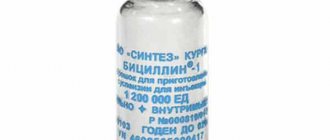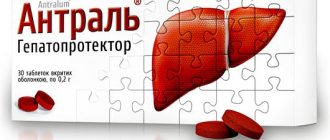Pharmacological properties of the drug Avodart
Pharmacodynamics . Dutasteride is a 5-α-reductase inhibitor that inhibits both type 1 and type 2 5-α-reductase isoenzymes, which are responsible for the conversion of testosterone to 5-α-dihydrotestosterone. Dihydrotestosterone is an androgen primarily responsible for hyperplasia of prostate tissue. The maximum decrease in dihydrotestosterone while taking Avodart depends on the dose and is observed in the first 1–2 weeks. After the 1st and 2nd weeks of treatment with Avodart at a daily dose of 0.5 mg, the average concentration of dihydrotestosterone decreases by 85 and 90%, respectively. In patients with benign prostatic hyperplasia receiving 0.5 mg dutasteride per day, the average decrease in dihydrotestosterone levels was 94% after 1 year and 93% after 2 years of treatment, the average testosterone level increased by 19% after 1 and 2 years. This is an expected consequence of 5-α-reductase inhibition and does not result in the various known side effects. According to multicenter, placebo-controlled, double-blind clinical studies involving 4,325 men with prostatic hyperplasia (30 cm3), the use of Avodart at a dose of 0.5 mg/day led to the prevention of disease progression both by reducing the risk of acute urinary retention and the need for surgical intervention, and a statistically significant improvement in the condition of the lower urinary tract, an increase in urination rate and a decrease in prostate volume compared to placebo. All of the above changes were noted over a period of 24 months. Pharmacokinetics . Dutasteride is used orally in the form of a solution in soft gelatin capsules. After taking a single dose of 0.5 mg, the maximum concentration of the drug in the blood plasma is observed after 1–3 hours. Absolute bioavailability is 60% and does not depend on food intake. Dutasteride after a single or multiple dose has a large volume of distribution (300–500 l). Binding to blood plasma proteins is 99.5%. When used in a daily dose of 60%, a constant equilibrium concentration of dutasteride in the blood plasma is achieved after 1 month of treatment and about 90% after 3 months. A constant equilibrium concentration of dutasteride of approximately 40 ng/ml in blood plasma is achieved after 6 months of administration at a daily dose of 0.5 mg. Similarly with blood plasma, a constant equilibrium concentration of dutasteride in seminal fluid is achieved after 6 months. After 52 weeks of treatment, the average concentration of dutasteride in seminal fluid is 3.4 ng/ml (range 0.4–14 ng/ml). The distribution ratio of dutasteride from blood plasma to seminal fluid is about 11.5%. In vitro, dutasteride is metabolized by human cytochrome P450 CYP3A4 enzymes to two monohydroxyl metabolites. In blood plasma, according to spectrometric analysis, unchanged dutasteride, 3 major metabolites (4-hydroxydutasteride, 1,2-dihydrodutasteride and 6-hydroxydutasteride) and 2 minor metabolites (6,4-dihydroxydutasteride and 15-hydroxydutasteride) are detected. Dutasteride is extensively metabolized. After oral administration of dutasteride at a dose of 0.5 mg/day, 1–15.4% (on average 5.4%) is excreted in the feces in the form of unchanged dutasteride, the rest in the form of metabolites. Traces of unchanged dutasteride (≤0.1%) are determined in urine. The final half-life of dutasteride is 3–6 weeks. Traces of dutasteride in blood plasma can be detected 4–6 months after the end of treatment.
Avodart capsule
Instructions for medical use of the drug
Indications for use
- treatment and prevention of progression of BPH (reduction in the size of the prostate gland, improvement of urination and reduction in the risk of acute urinary retention and the need for surgical treatment); - treatment and prevention of progression of BPH (reduction in the size of the prostate gland, relief of symptoms, including improved urination) in combination with α1-blockers (the combination of dutasteride and the α1-blocker - tamsulosin) has been studied.
Release form
capsules 0.5 mg; blister 10, cardboard pack 3. capsules 0.5 mg; blister 10, cardboard pack 9.
Pharmacodynamics
Dutasteride is a bivalent 5α-reductase inhibitor. Suppresses the activity of 5α-reductase isoenzymes types 1 and 2, which are responsible for the conversion of testosterone to 5α-dihydrotestosterone (DHT). Dihydrotestosterone is the main androgen responsible for hyperplasia of the glandular tissue of the prostate gland. Effect on the concentration of dihydrotestosterone and testosterone. The maximum effect of dutasteride on reducing dihydrotestosterone concentrations is dose-dependent and is observed 1–2 weeks after the start of treatment. After 1 and 2 weeks of taking dutasteride at a dose of 0.5 mg/day, median serum dihydrotestosterone concentrations decreased by 85% and 90%, respectively.
Pharmacokinetics
Absorption. After taking a single dose of 0.5 mg, Cmax of dutasteride in serum is achieved within 1-3 hours. Absolute bioavailability is about 60% relative to a 2-hour IV infusion. The bioavailability of dutasteride is independent of food intake. Distribution. Single and multiple doses of dutasteride are characterized by a higher Vd (from 300 to 500 l). Dutasteride has a high degree of binding to plasma proteins (>99.5%). When taken daily, dutasteride serum concentrations reach 65% of the steady-state level after 1 month and approximately 90% of this level after 3 months. Steady-state dutasteride serum concentrations (Css) of approximately 40 ng/ml are achieved after 6 months of daily dosing of 0.5 mg of the drug. In sperm, as in serum, steady-state concentrations of dutasteride are also achieved after 6 months. After 52 weeks of treatment, dutasteride concentrations in semen averaged 3.4 ng/ml (range 0.4 to 14 ng/ml). Approximately 11.5% of dutasteride passes from serum into sperm. Biotransformation. In vitro, dutasteride is metabolized by the CYP3A4 enzyme of the cytochrome P450 system to two minor monohydroxylated metabolites; however, it is not affected by the enzymes of this system CYP2C9, CYP2C19 and CYP2D6. Once the Css of dutasteride is reached in the serum, unchanged dutasteride, 3 major metabolites (4′-hydroxydutasteride, 1,2-dihydrodutasteride and 6-hydroxydutasteride) and 2 minor metabolites are detected by mass spectrometry. Elimination. Dutasteride undergoes extensive metabolism. After oral administration of dutasteride at a dose of 0.5 mg/day until a steady state is reached in humans, from 1.0 to 15.4% (on average 5.4%) of the dose taken is excreted unchanged in feces. The remainder of the dose is excreted as 4 major metabolites, accounting for 39%, 21%, 7% and 7%, respectively, and 6 minor metabolites (each accounting for less than 5%). Trace amounts of unchanged dutasteride are excreted in human urine (less than 0.1% of the dose). When taking therapeutic doses of dutasteride, its final half-life is 3-5 weeks. Dutasteride is detectable in serum (at concentrations above 0.1 ng/ml) up to 4–6 months after discontinuation of its use. Linearity/nonlinearity. The pharmacokinetics of dutasteride can be described as a first-order absorption process and two parallel elimination processes, one saturable (i.e., concentration-dependent) and one non-saturable (i.e., concentration-independent). At low serum concentrations (less than 3 ng/mL), dutasteride is rapidly eliminated by both elimination processes. After a single dose of 5 mg or less, dutasteride is quickly eliminated from the body and has a short half-life of 3–5 days. At serum concentrations above 3 ng/ml, dutasteride clearance occurs more slowly (0.35–0.58 l/h), predominantly through a linear, unsaturated elimination process with a final T1/2 of 3–5 weeks. At therapeutic concentrations, against the background of daily intake of 0.5 mg, slower clearance of dutasteride predominates; total clearance is linear and independent of concentration. Elderly men. The pharmacokinetics and pharmacodynamics of dutasteride were studied in 36 healthy men aged 24 to 87 years after taking one dose (5 mg) of the drug. There were no statistically significant differences between different age groups in such pharmacokinetic parameters of dutasteride as AUC and Cmax. There were also no statistically significant differences in the T1/2 of dutasteride between the age group 50–69 years and the age group over 70 years, which includes the majority of men with BPH. There were no significant differences between age groups in the degree of decline in dihydrotestosterone levels. These results demonstrate that there is no need to reduce the dose of dutasteride in elderly patients.
Contraindications for use
Hypersensitivity to dutasteride, other 5α-reductase inhibitors or any ingredient of the drug. Dutasteride is contraindicated in women and children.
Side effects
Data from clinical studies Monotherapy with dutasteride: impotence, changes (decreased) libido, impaired ejaculation, gynecomastia (includes pain and enlargement of the mammary glands). Combination therapy with dutasteride and tamsulosin: impotence, changes (decreased) libido, impaired ejaculation, gynecomastia (includes pain and enlargement of the mammary glands), dizziness. Observation data in routine clinical practice Very rarely - allergic reactions such as rash, itching, urticaria, localized swelling, angioedema.
Directions for use and doses
Orally, regardless of food intake, swallow whole, without chewing, and without opening the capsule, since the contents of the capsule may cause irritation of the mucous membrane of the oropharynx. Dutasteride can be used as monotherapy, as well as in combination with α1-blockers. The effect occurs quite quickly, but treatment should be continued for at least 6 months in order to objectively assess the effect of the drug. Adult men (including elderly) The recommended dose of dutasteride is 1 capsule. (0.5 mg) 1 time per day. Patients with impaired renal function When taking 0.5 mg of dutasteride per day, less than 0.1% of the dose is excreted in the urine, so dose adjustment is not required in patients with impaired renal function. Patients with impaired liver function Dutasteride undergoes intensive metabolism, and T1/2 is 3-5 weeks, so care must be taken when treating patients with impaired liver function.
Overdose
In case of overdose (taken at a dose 80 times higher than the therapeutic dose), no side effects were observed. Treatment: if an overdose is suspected, symptomatic and supportive treatment is sufficient. There is no specific antidote for dutasteride.
Interactions with other drugs
Dutasteride is metabolized by the CYP3A4 isoenzyme of the cytochrome P450 enzyme system. In the presence of CYP3A4 inhibitors, dutasteride blood concentrations may increase. With the simultaneous use of dutasteride with CYP3A4 inhibitors verapamil and diltiazem, a decrease in the clearance of dutasteride is observed. However, amlodipine, another CCB, does not reduce the clearance of dutasteride. The decrease in the clearance of dutasteride and the subsequent increase in its concentration in the blood, with the simultaneous use of this drug and CYP3A4 inhibitors, is not clinically significant due to the wide therapeutic index of this drug, so dose adjustment is not required. In vitro, dutasteride is not metabolized by the following isoenzymes of the human cytochrome P450 system: CYP1A2, CYP2C9, CYP2C19 and CYP2D6. Dutasteride does not inhibit in vitro enzymes of the cytochrome P450 system involved in the metabolism of drugs. Dutasteride does not displace warfarin, diazepam and phenytoin from their binding to plasma proteins, and these drugs, in turn, do not displace dutasteride. When dutasteride is used simultaneously with lipid-lowering drugs, ACE inhibitors, beta-blockers, CCBs, corticosteroids, diuretics, NSAIDs, phosphodiesterase type 5 inhibitors and quinolone antibiotics, no significant drug interactions are observed. No clinically significant drug interactions were found between dutasteride and tamsulosin, terazosin, warfarin, digoxin and cholestyramine.
Special instructions for use
Dutasteride is absorbed through the skin and therefore women and children should avoid contact with damaged capsules. In case of contact with damaged capsules, immediately wash the affected area of skin with soap and water. Effect on the detection of prostate-specific antigen and prostate cancer. In patients with BPH, it is necessary to conduct a digital rectal examination and other methods of examining the prostate gland before starting treatment with dutasteride and periodically repeat these studies during treatment to exclude the development of prostate cancer. Determination of serum prostate-specific antigen concentrations is an important component of the screening process for prostate cancer. Typically, additional testing is performed in patients with prostate-specific antigen concentrations above 4 ng/ml; in such cases, a prostate biopsy may be indicated. A baseline prostate-specific antigen level below 4 ng/ml in patients receiving dutasteride does not exclude the diagnosis of prostate cancer. After 6 months of therapy, dutasteride reduces serum prostate-specific antigen levels in patients with BPH by approximately 50%, even in the presence of prostate cancer. Despite individual differences, a decrease in prostate-specific antigen levels of approximately 50% is observed across the entire range of initial prostate-specific antigen concentrations (from 1.5 to 10 ng/ml). Thus, when interpreting prostate-specific antigen levels in a man who has been receiving dutasteride for 6 months or longer, the measured level should be multiplied by two and only then compared with the normal level without dutasteride therapy. This calculation of the content of prostate-specific antigen allows us to maintain the specificity and reliability of the analysis, as well as the ability of the test to detect prostate cancer. Any sustained increase in prostate-specific antigen levels during dutasteride therapy should be carefully evaluated, including the possibility of non-adherence to dutasteride therapy. The level of total prostate-specific antigen returns to its original value within 6 months after discontinuation of dutasteride. The ratio of free prostate-specific antigen to total remains constant even during dutasteride therapy. When this ratio is expressed in proportions to detect prostate cancer in men receiving dutasteride, no correction of this value is required. Combination therapy with tamsulosin. In two clinical studies lasting 4 years, the incidence of heart failure (a collective term since heart failure or congestive heart failure was predominantly reported) was higher in patients treated with dutasteride and an α-blocker, mainly tamsulosin, than in patients treated with dutasteride. patients who did not take this combination. In both studies, the incidence of heart failure was low (≤1%) and varied across studies. A cause-and-effect relationship between treatment with dutasteride as monotherapy or in combination with an α-blocker and the development of heart failure has not been established. Effect on fertility. The effect of dutasteride at a daily dose of 0.5 mg on sperm characteristics was studied in healthy volunteers aged 18–52 years. By week 52 of treatment, the mean percentage reductions in total sperm count, semen volume, and sperm motility were 23%, 26%, and 18%, respectively, compared to baseline. Sperm concentration and morphology did not change. A 30% reduction is considered clinically significant, so the clinical significance of the effect of dutasteride on individual patient fertility is unknown. Influence on the ability to drive a car and moving machinery. Taking dutasteride does not affect driving or operating machinery.
Storage conditions
At temperatures below 30 °C.
Best before date
48 months
ATX classification:
G Genitourinary system and sex hormones
G04 Preparations for the treatment of urological diseases
G04C Preparations for the treatment of benign prostatic hyperplasia
G04CB Testosterone 5-alpha reductase inhibitors
G04CB02 Dutasteride
Indications for use of the drug Avodart
Treatment and prevention of progression of benign prostatic hyperplasia by reducing the size of the prostate gland, reducing the severity of symptoms of the disease, improving urine flow, reducing the risk of acute urinary retention and, if necessary, surgical intervention. In combination with tamsulosin, it treats and prevents the progression of benign prostatic hyperplasia by reducing the size of the prostate gland, reducing the severity of symptoms of the disease and improving urine flow.
The mechanism of action on the male body
The main active component of Avodart is dutasteride. This substance shrinks the prostate gland, making the lumen of the urethra larger. In addition, this product also contains testosterone propionate, which in its properties is an analogue of the male hormone. An increase in the amount of testosterone in a man’s body affects 5-alpha reductase isoenzymes, reducing their activity, as a result of which the proliferation of prostate cells stops.
The use of Avodart has the following effects on the body:
- The growth of the prostate gland stops.
- There is an inflammatory process in the prostate.
- The accumulation of urine in the bladder is prevented.
- The prostate gland gradually decreases in size.
- Painful sensations decrease and spasms disappear.
- The course of metabolic processes in the prostate is restored.
- The risk of requiring surgery for treatment is reduced.
In general, Avodart is a popular effective remedy that is actively used today to eliminate prostate hypertrophy.
Use of the drug Avodart
Avodart can be prescribed as monotherapy or in combination with the α-receptor blocker tamsulosin (0.4 mg). Adult men (including elderly patients) The recommended dose of Avodart is 1 capsule (0.5 mg) per day orally. The capsule is swallowed whole, do not open or chew, since contact with the contents of the capsule may irritate the mucous membrane of the oral cavity and pharynx. Avodart can be taken with or without food. Despite the fact that a decrease in the severity of symptoms of the disease may be noted a short time after taking the drug, to objectively assess the effectiveness of the drug, treatment should be continued for at least 6 months. Renal failure For patients with renal failure, no dose adjustment is necessary. Hepatic impairment The pharmacokinetics of dutasteride have not been studied in patients with hepatic impairment.
Similar drugs:
- Diane-35 (Diane-35) Dragee
- Androcur Oral tablets
- Visanne Oral tablets
- Permixon Capsule
- Penester Oral tablets
- Prostamol Uno Capsule
- Bicalutamide-Teva Oral tablets
- Androcur Depot Solution for intramuscular administration
- Serpens Capsule
- Finasteride Oral tablets
** The Drug Directory is intended for informational purposes only. For more complete information, please refer to the manufacturer's instructions. Do not self-medicate; Before starting to use Avodart, you should consult a doctor. EUROLAB is not responsible for the consequences caused by the use of information posted on the portal. Any information on the site does not replace medical advice and cannot serve as a guarantee of the positive effect of the drug.
Are you interested in Avodart? Do you want to know more detailed information or do you need a doctor's examination? Or do you need an inspection? You can make an appointment with a doctor - the Euro lab is always at your service! The best doctors will examine you, advise you, provide the necessary assistance and make a diagnosis. You can also call a doctor at home . Euro lab clinic is open for you around the clock.
** Attention! The information presented in this medication guide is intended for medical professionals and should not be used as a basis for self-medication. The description of the drug Avodart is provided for informational purposes and is not intended for prescribing treatment without the participation of a doctor. Patients need to consult a specialist!
If you are interested in any other drugs and medications, their descriptions and instructions for use, information about the composition and form of release, indications for use and side effects, methods of use, prices and reviews of drugs, or you have any other questions and suggestions - write to us, we will definitely try to help you.
Side effects of Avodart
According to clinical studies Monotherapy with Avodart When used, the following adverse reactions were observed according to clinical studies with an incidence of 1% compared to placebo
Adverse reaction | Frequency of occurrence during the 1st year of treatment, % | Frequency of occurrence during the 2nd year of treatment, % | ||
Placebo (n=2158) | Avodart (n=2167) | Placebo (n=1736) | Avodart (n=1744) | |
| Impotence | 3 | 6 | 1 | 2 |
| Change (decrease) in libido | 2 | 4 | ≤1 | ≤1 |
| Ejaculation disorder | ≤1 | 2 | ≤1 | ≤1 |
| Gynecomastia* | ≤1 | 1 | ≤1 | 1 |
* including soreness and hypertrophy of the mammary glands.
According to subsequent two-year clinical studies, the side effect profile of the drug did not change. Combination therapy (Avodart + tamsulosin) The following adverse reactions were noted in clinical studies with an incidence of 1% when comparing the combination of Avodart and tamsulosin and monotherapy with these drugs
Adverse reaction | Frequency of occurrence during the 1st year of treatment, % | Frequency of occurrence during the 2nd year of treatment, % | ||||
Avodart+ tamsulosin (n=1610) | Avodart (n=1623) | Tamsulosin (n=1611) | Avodart+ tamsulosin (n=1424) | Avodart (n=1457) | Tamsulosin (n=1468) | |
| Impotence | 7% | 5% | 3% | 1% | 1% | ≤1% |
| Change (decrease) in libido | 5 | 4 | 3 | ≤1 | ≤1 | ≤1 |
| Ejaculation disorder | 9 | 2 | 3 | ≤1 | ≤1 | ≤1 |
| Gynecomastia * | 2 | 2 | ≤1 | ≤1 | 1 | ≤1 |
| Dizziness | 1 | ≤1 | 1 | ≤1 | ≤1 | ≤1 |
* including soreness and hypertrophy of the mammary glands.
Data from post-marketing studies. From the immune system: very rarely - allergic reactions, including rash, itching, urticaria, localized edema and angioedema.
Side effects after taking
According to reviews from those who were treated with Avodart, this drug is quite easily tolerated. However, there are still a number of side effects that may occur as a result of taking this medication:
- hives and other skin rashes;
- itching;
- swelling;
- angioedema;
- a state of apathy, sometimes even depression;
- testicular swelling and the pain that accompanies it;
- hypertrichosis and body hair loss;
- erectile dysfunction, decreased sexual desire, problems with ejaculation.
The likelihood of side effects depends on the duration of the course of treatment, as well as on the use of other drugs. Sometimes the cause of side effects can be an unsuccessful combination of medications or taking the medicine for too long. In some patients, the cumulative effect provokes the appearance of reactions in the body.
Special instructions for the use of Avodart
Dutasteride can be absorbed through the skin, so women and children should avoid contact with leaking capsules. If liquid from the capsule gets on your skin, it should be washed off immediately with soap and water. The effect of liver failure on the pharmacokinetics of dutasteride has not been studied. Since dutasteride is extensively metabolized and its half-life is 3–5 weeks, the drug is used with caution in liver diseases. Effect on prostate specific antigen (PSA) and prostate cancer detection. Before starting a course of treatment with dutasteride and periodically during treatment, a digital rectal examination of the patient and other tests should be performed to detect prostate cancer. PSA concentration is an important component of the screening method for detecting prostate cancer. Typically, a plasma PSA concentration of 4 ng/mL (Hybritech) requires further evaluation and a prostate biopsy. It should also be taken into account that a baseline PSA level of ≤4 ng/ml in patients receiving dutasteride does not exclude the possibility of diagnosing prostate cancer. Treatment with Avodart can reduce plasma PSA levels in benign prostatic hyperplasia by approximately 50% after 6 months, even in the presence of prostate cancer. Although there may be individual variations, a reduction in PSA of approximately 50% is predicted as it was observed across the entire range of baseline PSA values (1.5 to 10 ng/mL). In order to interpret the PSA value in men who have taken Avodart for 6 months or more, the PSA value should be doubled for comparison with the normal PSA ranges in men who have not been treated. This correction maintains the sensitivity and specificity of the PSA test and allows this test to detect prostate cancer. Any persistent increase in PSA levels during treatment with Avodart requires careful consideration, including a decision regarding the inappropriateness of treatment with Avodart. Total serum PSA levels return to baseline within 6 months after cessation of treatment. The ratio of free PSA to total PSA remains constant even during treatment with Avodart. Therefore, when using the percentage of free PSA in a patient taking Avodart to diagnose prostate cancer, doubling the free PSA value should not be used. Fertility A study of the effect of dutasteride at a dose of 0.5 mg / day on the characteristics of the ejaculate in 27 healthy volunteers over 52 weeks of treatment and 24 weeks of follow-up revealed a decrease in total sperm count, ejaculate volume and sperm motility by 23; 26 and 18% compared with changes in the placebo group. Sperm concentration and morphology remained unchanged. At 24 weeks of follow-up, the mean percentage change in total sperm count in the dutasteride group remained 23% below baseline. While the mean values for all semen parameters at all periods remained within the normal range and did not meet certain criteria for clinically significant changes (30%), 2 patients in the dutasteride group had a decrease in sperm count of more than 90% compared to baseline level at the 52nd week of treatment and a partial restoration of their number after 24 weeks of follow-up. The clinical significance of the effect of dutasteride on sperm characteristics for individual patient fertility is not known. During pregnancy and breastfeeding . Dutasteride is contraindicated for use in women. The use of dutasteride for the treatment of women has not been studied, since preclinical studies suggest that a decrease in the level of circulating dihydrotestosterone may lead to impaired development of the external genitalia in the male fetus. Children . Use is contraindicated. Considering the pharmacokinetic and pharmacodynamic properties, dutasteride does not affect the reaction rate when driving vehicles or working with machinery .
Interactions with other medicinal drugs and other types of interactions
Information on how to reduce PSA levels (Prostate-specific antigen) in blood serum during treatment with dutasteride, as well as information on how to detect prostate cancer. in the section “Peculiarities of stagnation”.
Influence of other drugs on the pharmacokinetics of dutasteride
Concomitant administration with CYP3A4 inhibitors and/or P-glycoprotein:
It is important for dutasteride to be eliminated by metabolism. In vitro follow-up
show that the catalysts for metabolism are CYP3A4 and CYP3A5. No formal interaction studies with active CYP3A4 inhibitors have been conducted. Based on population pharmacokinetics studies, dutasteride concentrations in serum were on average 1.6–1.8 times higher in a small number of patients who were simultaneously treated with verapamil or diltiazem (moderate CYP3A4 inhibitors and P-glycoprotein inhibitors), lower in other patients .
In the case of a trial combination of dutasteride with drugs that are potent inhibitors of the CYP3A4 enzyme (for example, ritonavir, indinavir, nefazodone, itraconazole, ketoconazole, which were administered orally), concentrate The effect of dutasteride in serum may be increased. Further inhibition of 5α-reductase with increased toxicity of dutasteride is low-virgin. It is also possible to change the frequency of dosing of dutasteride depending on the development of side effects. This means that in cases where enzyme activity is inhibited, a long period of recovery may be longer and in this case, concomitant therapy may be continued for at least 6 months before a new, equal concentration is achieved. .
Administration of 12 g of cholestyramine 1 year after administration of a single dose of 5 mg of dutasteride did not affect the pharmacokinetics of dutasteride.
The impact of dutasteride on the pharmacokinetics of other drugs
Dutasteride does not affect the pharmacokinetics of warfarin or digoxin. This indicates that dutasteride does not inhibit/induce activity of the CYP2C9 enzyme or the transporter P-glycoprotein. Data on interaction in vitro
indicate that dutasteride does not inhibit the enzymes CYP1A2, CYP2D6, CYP2C9, CYP2C19 or CYP3A4.
In a small study (N=24), dutasteride (0.5 mg per dose) tested two times in healthy subjects without affecting the pharmacokinetics of tamsulosin or terazosin.
The study also did not show any sign of pharmacodynamic interaction. Features of stagnation.
Combination therapy may be indicated after a thorough assessment of the risk of adverse reactions (including heart failure) and after consideration of alternative treatment options, including monotherapy (div. section “Method of administration and dosage”).
Adverse reactions from the side of the cardiovascular system
Based on data from two 4-arm clinical studies, the incidence of primary heart failure and congestive heart failure was high. in patients who were treated with the combination of Avodart with an alpha blocker, the main ingredient is tamsulosin, compared with patients , but such combinations were not created. In these two studies, the incidence of heart failure was low (≤ 1%) and variable between studies. Disproportions in the frequency of cardiovascular side effects are not worth following. A causal relationship between the drug dutasteride (along with the combination with alpha blockers) and heart failure has not been established (“Pharmacological Authorities”).
A meta-analysis of 12 randomized, placebo-controlled or equalized clinical studies (n = 18,802) was conducted, which assessed the risk of developing adverse reactions in the cardiovascular system during ingestion of dutasteride (at the time study with the control group). There was no consistent statistically significant increase in the risk of heart failure (RR 1.05; 95% CI 0.71, 1.57), acute myocardial infarction (RR 1.00; 95% CI 0.77, 1.30) or stroke (RR 1.20; 95% CI 0.88, 1.64).
Prostate-specific antigen (PSA) test
The concentration of prostate-specific antigen (PSA) is an important component of the screening process for detecting prostate cancer.
Avodart reduces the level of serum PSA in patients by approximately 50% after 6 months of treatment.
Patients taking Avodart are expected to have new PSA results 6 months after treatment with this drug. Over the course of the year, it is recommended to check this rhubarb regularly. If an increase in the PSA level from the lowest level is confirmed during the hour of stagnation of Avodart, there may be evidence of cancer of the anterior ovary, or failure to comply with the treatment regimen with Avodart will require careful treatment, however There are cases where PSA values are within the normal range for men who have not been treated with 5a-reductase inhibitors. When interpreting PSA readings in patients treated with Avodart, please refer to the PSA readings first for alignment.
Avodart treatment does not contribute to the PSA level for diagnosing anterior gland cancer after the establishment of a new output level.
The final level of serum PSA turns to the output level over a period of 6 months after treatment.
The relationship between the free PSA and the legal level of PSA is lost in the hour of treatment with Avodart. If for a patient who takes Avodart, the doctor believes that it is necessary to treat cancer of the anterior gland with hundreds of high-quality PSA, adjustment of this value is not necessary.
Before starting a course of treatment with dutasteride and periodically during the course of treatment, it is necessary to perform digital rectal closure of the patient, as well as use other methods for detecting cancer of the anterior gland.
Cancer of the anterior mole and swelling of a high level of gradation after Gleason (low differentiation)
During a 4-line clinical follow-up of > 8000 people with 50 to 75 cases of early negative results of a biopsy of the anterior gland cancer and the final level of PSA between 2.5 ng/ml and 10.0 ng/ml (REDUCE follow-up study) 1517 diagnoses of cancer of the anterior pelvis. The frequency of anterior tumors (8–10 on the Gleason scale) in the group of patients who took Avodart (n = 29.09%), was more similar to the group who received placebo (n = 19.06%). An increase in the incidence of anterior gland cancer beyond the Gleason scale of 5–6 and 7–10 was not observed. A causal relationship between the stagnation of Avodart and high stages of anterior pelvic cancer has not been established. The clinical significance of the numerical disproportion is unknown. People who use Avodart are required to undergo regular screening for the risk of breast cancer, including PSA testing.
In a follow-up 2-year follow-up study of patients who took part in the follow-up study of drug-containing dutasteride as chemical prophylaxis (the REDUCE study), a low frequency of new infections was found. susceptible to anterior cancer (dutasteride group [n=14, 1.2%] and group placebo [n=7, 0.7%]) with a number of newly identified cases of anterior gland cancer with a differentiation of 8–10 points on the Gleason scale.
Clinical follow-up of patients treated with another 5α-reductase inhibitor (finasteride) as a chemical prophylaxis was not statistically shown to be consistent (up to 18 years) There was a significant difference between the finasteride and placebo groups in the rates of intravenous survival (HR 1.02, 95% CI 0. 97–1.08) or survival after diagnosing cancer of the anterior pelvis (HR 1.01, 95% CI 0.85–1.20).
Breast cancer
Rare incidences of breast cancer have been reported in humans during clinical follow-up and in the post-marketing period. In this case, epidemiological studies indicate that there is an increased risk of developing breast cancer in humans when treated with 5α-reductase inhibitors. Patients must be advised of any changes in the breast tissue, such as visible from the nipple or swelling.
Leaky capsules
Dutasteride is absorbed through the skin, so women and children may not come into contact with leaking capsules. If you rub the capsule from the capsule onto your skin, carefully wash it off with water and honey.
Pechinkova deficiency
The effect of liver failure on the pharmacokinetics of dutasteride was not affected. Due to the active metabolism of dutasteride, the 3–5-day period of treatment with dutasteride in patients with mild or mild hepatic insufficiency should be carried out with care (sections “Method of treatment and doses", "Contraindications", "Pharmacological authorities").
Suspension during pregnancy or breastfeeding.
Dutasteride is contraindicated for female bathing.
Suspension during pregnancy
Like other 5α-reductase inhibitors, dutasteride interferes with the conversion of testosterone to dihydrotestosterone, which can interfere with the development of external organs in the human fetus. A small amount of dutasteride was detected in the ejaculate of subjects who took 0.5 mg of Avodart per dose. It is unknown how much dutasteride is injected into the body of a woman in the family of a man who is treated with dutasteride in the human body (this risk is the greatest extent of the first 16 years of life) ).
If other 5α-reductase inhibitors are present, it is recommended to use condoms if the patient's partner is vaginal or may potentially become pregnant, thereby avoiding wasting it. I care about a woman's body.
Suspension during the period of breastfeeding
It is unknown whether dutasteride passes into breast milk.
Fertility
Effects of dutasteride on the characteristics of ejaculate (changes in sperm count, ejaculate volume and sperm flow) have been reported in healthy individuals.
Do not exclude the risk of decreased human fertility. This is due to the fluidity of the reaction during treatment with vehicles or other mechanisms.
Based on the pharmacokinetic and pharmacodynamic properties of dutasteride, it does not affect the effect of ceruvate in the vehicle and other mechanisms.
Avodart drug interactions
Since dutasteride is metabolized by the CYP3A4 isoenzyme, plasma concentrations of dutasteride may be increased in the presence of CYP3A4 inhibitors, and the clearance of dutasteride is decreased when administered concomitantly with the CYP3A4 inhibitors verapamil (37%) and diltiazem (44%). However, the clearance of dutasteride is not reduced when used with another calcium channel antagonist, amlodipine. The decrease in clearance and corresponding increase in the effect of dutasteride in the presence of CYP3A4 inhibitors is not of great clinical significance due to the wide range of safety of the drug. In vitro, the isoenzymes CYP 1A2, CYP 2C9, CYP2 C19 and CYP 2D6 do not take part in the metabolism of dutasteride in humans; dutasteride does not inhibit enzymes of the cytochrome P450 system in humans involved in the metabolism of drugs. In vitro studies have shown that dutasteride does not displace warfarin, diazepam or phenytoin from binding to plasma proteins, nor do these components replace dutasteride. The interaction of dutasteride with tamsulosin, terazocin, warfarin, digoxin and cholestyramine was studied. No clinically significant interaction was identified. Although specific drug interaction studies have not been conducted, approximately 90% of all patients in clinical trials of dutasteride received other concomitant therapy. No clinically significant adverse reactions were observed with the simultaneous use of dutasteride with antihyperlipidemic drugs, ACE inhibitors, β-adrenergic receptor blockers, calcium channel blockers, corticosteroids, diuretics, NSAIDs, phosphodiesterase type V inhibitors and quinolone antibiotics. According to a study examining the interaction of tamsulosin or terazocin in combination with Avodart for 2 weeks, no signs of pharmacokinetic or pharmacodynamic interaction were identified.
Avodart overdose, symptoms and treatment
According to clinical studies, in volunteers a single dose of dutasteride up to 40 mg/day (80 times higher than the therapeutic dose) for 7 days did not cause undesirable manifestations, taking into account the safety of their use. In clinical studies, a dose of dutasteride was used at a dose of 5 mg/day for 6 months without the occurrence of additional adverse reactions compared to the use of dutasteride at a dose of 0.5 mg/day. There is no specific antidote, so in case of possible overdose, symptomatic therapy is carried out.








